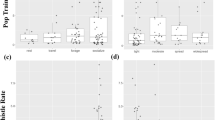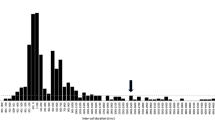Abstract
Theory predicts that females in species with matrilineal dominance hierarchies should use nepotistic support systems to maintain their family’s rank. Female Old World monkeys, however, form alliances against other females at surprisingly low rates. Nonetheless, in many species, females utter threat vocalizations when observing others’ disputes, suggesting that these vocalizations may function as ‘vocal alliances’. We describe a playback experiment testing the efficacy of vocal alliances in free-ranging female baboons. Subjects were played the same female’s threat-grunts under three separate conditions: after being threatened by the signaller’s close relative to mimic kin support, after being threatened by a female maternally unrelated to the signaller to mimic non-kin support, and after a friendly interaction with the signaller’s close relative as a control. Subjects responded more strongly to the playback and avoided the signaller and her matrilineal relatives for a longer period of time in kin support trials than in either non-kin support or no aggression trials. In contrast, there was no difference in subjects’ behaviour between non-kin support and no aggression trials. These results corroborate observational data showing that vocal support occurs at a higher rate than physical support in female baboons, and that kin are more likely to provide vocal support than non-kin. We conclude that vocal support plays a similar role as physical support in the alliances of female baboons.





Similar content being viewed by others
References
Alberts SC (1999) Paternal kin discrimination in wild baboons. Proc R Soc Lond B 266:1501–1506. DOI 10.1098/rspb.1999.0807
Altmann J (1974) Observational study of behavior: sampling methods. Behaviour 49:227–267
Altmann J, Alberts SC, Haines SA, Dubach J, Muruthi P, Coote T, Geffen E, Cheesman DJ, Mututua RS, Saiyalel SN, Wayne RK, Lacy RC, Bruford MW (1996) Behavior predicts genetic structure in a wild primate group. Proc Natl Acad Sci 93:5797–5801. DOI 10.1073/pnas.93.12.5797
Barrett L, Henzi SP, Weingrill T, Lycett JE, Hill RA (1999) Market forces predict grooming reciprocity in female baboons. Proc R Soc Lond B 266:665–670. DOI 10.1098/rspb.1999.0687
Bergman TJ, Beehner JC, Cheney DL, Seyfarth RM (2003) Hierarchical classification by rank and kinship in baboons. Science 302:1234–1236. DOI 10.1126/science.1087513
Bernstein IS, Ehardt CL (1985) Agonistic aiding: kinship, rank, age, and sex influences. Am J Primatol 8:37–52. DOI 10.1002/ajp.1350080105
Bradbury J, Vehrencamp SL (1998) The principles of animal communication. Sinauer, Sunderland, MA
Bulger J (1993) Dominance rank and access to estrous females in savanna baboons. Behaviour 127:67–103
Bulger J, Hamilton WJ (1987) Rank and density correlates of inclusive fitness measures in a natural chacma baboon (Papio ursinus) troop. Int J Primatol 8:635–650
Chapais B (1988) Rank maintenance in female Japanese macaques—experimental—evidence for social dependency. Behaviour 104:41–59
Chapais B (2001) Primate nepotism: what is the explanatory value of kin selection? Int J Primatol 22:203–229. DOI 10.1023/A:1005619430744
Chapais B, Girard M, Primi G (1991) Non-kin alliances and the stability of matrilineal dominance relations in Japanese macaques. Anim Behav 41:481–491. DOI 10.1016/S0003-3472(05)80851-6
Cheney DL, Seyfarth RM (1990) How monkeys see the world. University of Chicago Press, Chicago, IL
Cheney DL, Seyfarth RM (1997) Reconciliatory grunts by dominant female baboons influence victims’ behaviour. Anim Behav 54:409–418. DOI 10.1006/anbe.1996.0438
Cheney DL, Seyfarth RM (1999) Recognition of other individuals’ social relationships by female baboons. Anim Behav 58:67–75. DOI 10.1006/anbe.1999.1131
Cheney DL, Seyfarth RM (2007) Baboon’s metaphysics. The evolution of social mind. University of Chicago Press, Chicago, IL (in press)
Cheney DL, Seyfarth RM, Fischer J, Beehner J, Bergman T, Johnson E, Kitchen DM, Palombit RA, Rendall D, Silk JB (2004) Factors affecting reproduction and mortality among baboons in the Okavango Delta, Botswana. Int J Primatol 25:401–428. DOI 10.1023/B:IJOP.0000019159.75573.13
de Waal FBM (1977) Organization of agonistic relations within two captive groups of Java-monkeys (Macaca fascicularis). Z Tierpsychol 44:225–282
Engh AL, Hoffmeier RR, Cheney DL, Seyfarth RM (2006a) Who me? Can baboons infer the target of vocalizations? Anim Behav 71:381–387. DOI 10.1016/j.anbehav.2005.05.009
Engh AL, Beehner JC, Bergman TJ, Whitten PL, Hoffmeier RR, Seyfarth RM, Cheney DL (2006b) Female hierarchy instability, male immigration, and infanticide increase glucocorticoid levels in female chacma baboons. Anim Behav 71:1227–1237. DOI 10.1016/j.anbehav.2005.11.009
Kaplan JR, Chikazawa DK, Manuck SB (1987) Aspects of fight interference in free-ranging and compound-dwelling rhesus macaques (Macaca mulatta). Am J Primatol 12:287–298. DOI 10.1002/ajp.1350120306
Kitchen DM, Seyfarth RM, Fischer J, Cheney DL (2003) Loud calls as indicator for dominance in male baboons (Papio cynocephalus ursinus). Behav Ecol Sociobiol 53:374–384. DOI 10.1007/s00265-003-0588-1
Koenig A (2002) Competition for resources and its behavioral consequences among female primates. Int J Primatol 23:759–783. DOI 10.1023/A:1015524931226
Maynard Smith J (1982) Evolution and the theory of games. Cambridge University Press, Cambridge
Mundry R, Fischer J (1998) Use of statistical programs for nonparametric tests of small samples often leads to incorrect P values: examples from animal behaviour. Anim Behav 56:256–259. DOI 10.1006/anbe.1998.0756
Owren MJ, Seyfarth RM, Cheney DL (1997) The acoustic features of vowel-like grunt calls in chacma baboons, Papio cynocephalus ursinus: implications for production processes and functions. J Acoust Soc Am 101:2951–2963. DOI 10.1121/1.418523
Samuels A, Silk JB, Altmann J (1987) Continuity and change in dominance relations among female baboons. Anim Behav 35:785–793. DOI 10.1016/S0003-3472(87)80115-X
Siegel S, Castellan NJ Jr. (1988) Nonparametric statistics for the behavioral sciences, 2nd edn. McGraw-Hill, New York, NY
Silk JB (2002a) Kin selection in primate groups. Int J Primatol 23:849–875. DOI 10.1023/A:1015581016205
Silk JB (2002b) Females, food, family and friendship. Evol Anthropol 11:85–87. DOI 10.1002/evan10011
Silk JB, Seyfarth RM, Cheney DL (1999) The structure of social relationships among female savannah baboons in Moremi Reserve, Botswana. Behaviour 136:679–703. DOI 10.1163/156853999501522
Silk JB, Alberts SC, Altmann J (2004) Patterns of coalition formation by adult female baboons in Amboseli, Kenya. Anim Behav 67:573–582. DOI 10.1016/j.anbehav.2003.07.001
Silk JB, Altmann J, Alberts SC (2006a) Social relationships among adult female baboons (Papio cynocephalus) I. Sources of variation in the strength of social bonds. Behav Ecol Sociobiol. DOI 10.1007/s00265-006-0249-2
Silk JB, Altmann J, Alberts SC (2006b) Social relationships among adult female baboons (Papio cynocephalus) II. Variation in the quality and stability of social bonds. Behav Ecol Sociobiol. DOI 10.1007/s00265-006-0250-9
Smith K, Alberts SC, Altmann J (2003) Wild female baboons bias their social behaviour towards paternal half-sisters. Proc R Soc B 270:503–510. DOI 10.1098/rspb.2002.2277
Sterck EHM, Watts DP, van Schaik CP (1997) The evolution of female social relationships in nonhuman primates. Behav Ecol Sociobiol 41:291–309. DOI 10.1007/s002650050390
Tabachnick BG, Fidell LS (2007) Using multivariate statistics, 5th edn. Allyn and Bacon, Boston, MA
van Schaik CP (1989) The ecology of social relationships amongst primates. In: Standen V, Foley RA (eds) Comparative socioecology. The behavioural ecology of humans and other mammals. Blackwell, Oxford, pp 195–218
Vasey PL (1996) Interventions and alliance formation between female Japanese macaques, Macaca fuscata, during homosexual consortships. Anim Behav 52:539–551. DOI 10.1006/anbe.1996.0196
Walters JR, Seyfarth RM (1987) Conflict and cooperation. In: Smuts BB, Cheney DL, Seyfarth RM, Wrangham RW, Struhsaker TT (eds) Primate societies. University of Chicago Press, Chicago, IL, pp 306–317
Widdig A, Nürnberg P, Krawczak M, Streich WJ, Berkovitch FB (2001) Paternal relatedness and age proximity regulate social relationships among adult female rhesus macaques. Proc Natl Acad Sci 98:13769–13773. DOI 10.1073/pnas.24120198
Widdig A, Nürnberg P, Krawczak M, Streich WJ, Berkovitch FB (2002) Affiliation and aggression among adult female rhesus macaques: a genetic analysis of paternal cohorts. Behaviour 139:371–391. DOI 10.1163/156853902760102717
Wittig RM, Boesch C (2003a) The choice of post-conflict interactions in wild chimpanzees (Pan troglodytes). Behaviour 140:1527–1559. DOI 10.1163/156853903771980701
Wittig RM, Boesch C (2003b) “Decision-making” in conflicts of wild chimpanzees (Pan troglodytes): an extension of the relational model. Behav Ecol Sociobiol 54:491–504. DOI 10.1007/s00265-003-0654-8, DOI 10.1007/s00265-003-0696-y
Wrangham RW (1980) An ecological model of female-bonded primate groups. Behaviour 75:262–300
Acknowledgement
We thank the Office of the President and the Department of Wildlife and National Parks of the Republic of Botswana for permission to conduct this research. Alec Mokopi, Mokopi Mokopi, and Eva Wikberg provided invaluable assistance in the field with data collection and with conducting the experiments. We are grateful to Julia Fischer, Julia Lehmann, and Simone Pika for their help during different stages of the project and to Drew Rendall for his comments on an earlier version of the manuscript. Research was supported by the National Institutes of Health grant no. MH62249, the Deutsche Forschungsgemeinschaft research fellowship WI 2637/2-1, and the Department of Linguistics of the MPI EVA, Leipzig. This research was reviewed and approved by the Animal Care and Use Committee at the University of Pennsylvania. We would like to dedicate this research to M. Mokopi who died recently.
Author information
Authors and Affiliations
Corresponding author
Additional information
Communicated by A. Widdig
Rights and permissions
About this article
Cite this article
Wittig, R.M., Crockford, C., Seyfarth, R.M. et al. Vocal alliances in Chacma baboons (Papio hamadryas ursinus). Behav Ecol Sociobiol 61, 899–909 (2007). https://doi.org/10.1007/s00265-006-0319-5
Received:
Revised:
Accepted:
Published:
Issue Date:
DOI: https://doi.org/10.1007/s00265-006-0319-5




